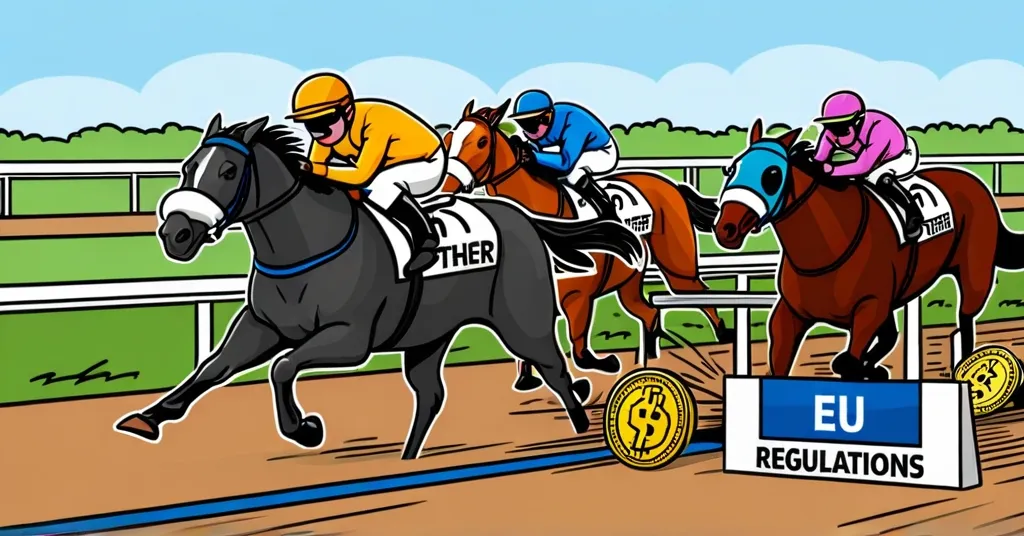Crypto Exchanges Launch Stablecoins as Tether’s EU Market Share Declines

Crypto Exchanges Launch Stablecoins Amid Tether’s Declining Dominance Due to EU Regulations
As Tether’s grip on the stablecoin market loosens due to stringent European regulations, major crypto exchanges like Kraken and Crypto.com are stepping up to fill the void with their own U.S. dollar-pegged stablecoins. Meanwhile, Coinbase and Binance are opting for strategic partnerships with established issuers like Circle, indicating a dynamic shift in the stablecoin landscape.
- EU regulations mandate delisting of non-compliant stablecoins by March 31, 2025.
- Kraken and Crypto.com developing proprietary stablecoins.
- Tether’s market share drops from 70% to 63%.
- Coinbase and Binance partner with Circle to promote USDC.
- Gemini steps back from GUSD expansion in Europe.
- Stablecoin issuance remains highly profitable.
The European Union’s Markets in Crypto-Assets (MiCA) regulation has thrown a wrench into the stablecoin market. By March 31, 2025, all stablecoins operating within the EU must comply with these new rules, which include obtaining special banking permits known as electronic money licenses. Non-compliant stablecoins, like Tether’s USDT, face delisting, pushing exchanges to innovate and adapt. More details on the 2025 compliance requirements can be found through the European Securities and Markets Authority.
Kraken, through its Irish entity, is crafting its own U.S. dollar-pegged stablecoin. Although it won’t meet the regulatory deadline, Kraken’s long-term strategy signals a commitment to compliance and market presence. On the other hand, Crypto.com is playing it cool, planning to launch its stablecoin in Q3 2025, perfectly timed to meet EU regulations. Both moves reflect a broader trend of exchanges seeking to maintain liquidity and control over their platforms.
Not everyone is jumping on the stablecoin bandwagon with the same gusto. Coinbase and Binance, for instance, are taking a different route by partnering with Circle, the issuer of USDC. This move not only ensures compliance but also leverages USDC’s growing acceptance in the market. By aligning with established players, these exchanges mitigate regulatory risks while positioning themselves favorably in a market where trust and stability are paramount.
However, not all are eager to dive into the stablecoin pool. Gemini, for example, has retreated from plans to expand its GUSD stablecoin to Europe, likely daunted by the regulatory complexities. This cautious approach underscores the diverse strategies exchanges are adopting in response to the EU’s regulatory clampdown. Discussions on Reddit about crypto exchanges and stablecoins provide further insight into community sentiments.
So why the sudden interest in stablecoins? It’s not just about replacing Tether. It’s also about the lucrative nature of stablecoin issuance. Tether reported a staggering $13 billion in unaudited profits last year, highlighting the potential for significant returns. Stablecoins serve as the lifeblood of the crypto economy, facilitating transactions and bridging the gap between digital and traditional finance. As regulations evolve, so do the opportunities for profit and innovation. The impact of these regulations on Tether, in particular, is discussed on Quora, with insights into the broader impact of EU regulations on Tether.
The rise of proprietary stablecoins and strategic partnerships underscores a market that is maturing and adapting. While Tether’s dominance fades, new players and alliances are reshaping the landscape. Yet, the journey is fraught with challenges—from high compliance stakes to international regulatory complexities and market volatility. For those willing to navigate these waters, the rewards could be substantial, potentially reshaping the financial landscape one stablecoin at a time.
Amidst this shift, it’s crucial to remember that stablecoins play a vital role in the broader context of decentralization and financial innovation. While Bitcoin remains the flagship cryptocurrency, stablecoins enable the practical use of digital assets in everyday transactions, filling niches that Bitcoin alone cannot serve. A comprehensive overview of EU regulations on stablecoins can be found on Wikipedia.
Here are the key takeaways:
- Why are crypto exchanges entering the stablecoin market?
Crypto exchanges are launching their own stablecoins to capitalize on Tether’s declining dominance and navigate the changing regulatory landscape in Europe.
- What regulatory changes are affecting the stablecoin market in Europe?
New EU regulations, including the MiCA regulation, require stablecoin issuers to hold an electronic money license, leading to the delisting of non-compliant stablecoins like USDT by March 31, 2025.
- How are exchanges like Kraken and Crypto.com responding to these changes?
Kraken is developing its own U.S. dollar-pegged stablecoin, while Crypto.com plans to launch its stablecoin in Q3 2025, both aiming to comply with European regulations.
- What is the impact on Tether’s market share?
Tether’s market share has decreased from 70% to 63%, indicating a weakening dominance as new stablecoins enter the market and regulatory pressures mount.
- How are other exchanges like Coinbase and Binance adapting to the regulatory environment?
Coinbase and Binance are partnering with Circle, the issuer of USDC, to offer a compliant alternative to Tether in Europe.
- Why did Gemini retreat from its plans to expand GUSD to Europe?
Gemini’s retreat from expanding GUSD to Europe may be due to the complexities and regulatory challenges of operating in the European market.
- What does the profitability of stablecoin issuance suggest about the market’s future?
The high profits reported by Tether ($13 billion) suggest that stablecoin issuance remains a lucrative business, likely encouraging more competition and innovation in the market despite regulatory hurdles.



